Marketing Strategies 1: Customer Satisfaction and Omnichannel Report
VerifiedAdded on 2022/08/19
|5
|1065
|14
Report
AI Summary
This report provides an analysis of marketing strategies with a focus on improving customer experience through the adoption of omnichannel strategies. It begins by highlighting the shift towards online marketing and the changing preferences of customers, emphasizing the need for businesses to adapt to meet these evolving needs. Despite the growth of e-commerce, the report notes that the offline retail sector still accounts for a significant portion of the market. It discusses how consumers often research products online before making in-store purchases, and how retailers are integrating online and offline channels to provide a seamless shopping experience. The report references studies that show the importance of customer service satisfaction, regardless of the purchase channel, and highlights examples of companies successfully integrating online and offline strategies to meet customer needs, such as Under Armour's approach to integrating customer activity data. The conclusion emphasizes the continued relevance of both online and offline channels in providing satisfactory services.
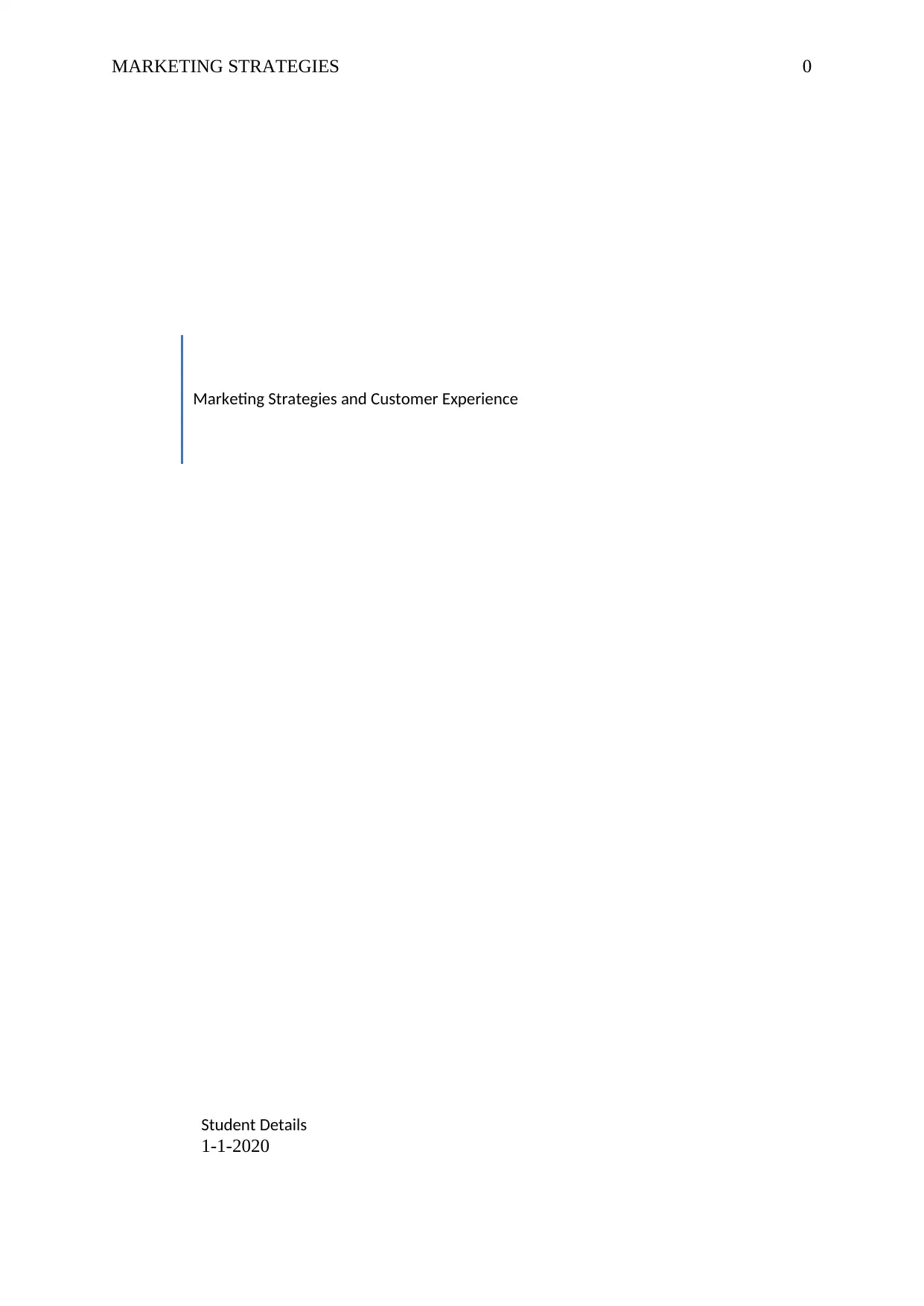
MARKETING STRATEGIES 0
Marketing Strategies and Customer Experience
Student Details
1-1-2020
Marketing Strategies and Customer Experience
Student Details
1-1-2020
Paraphrase This Document
Need a fresh take? Get an instant paraphrase of this document with our AI Paraphraser
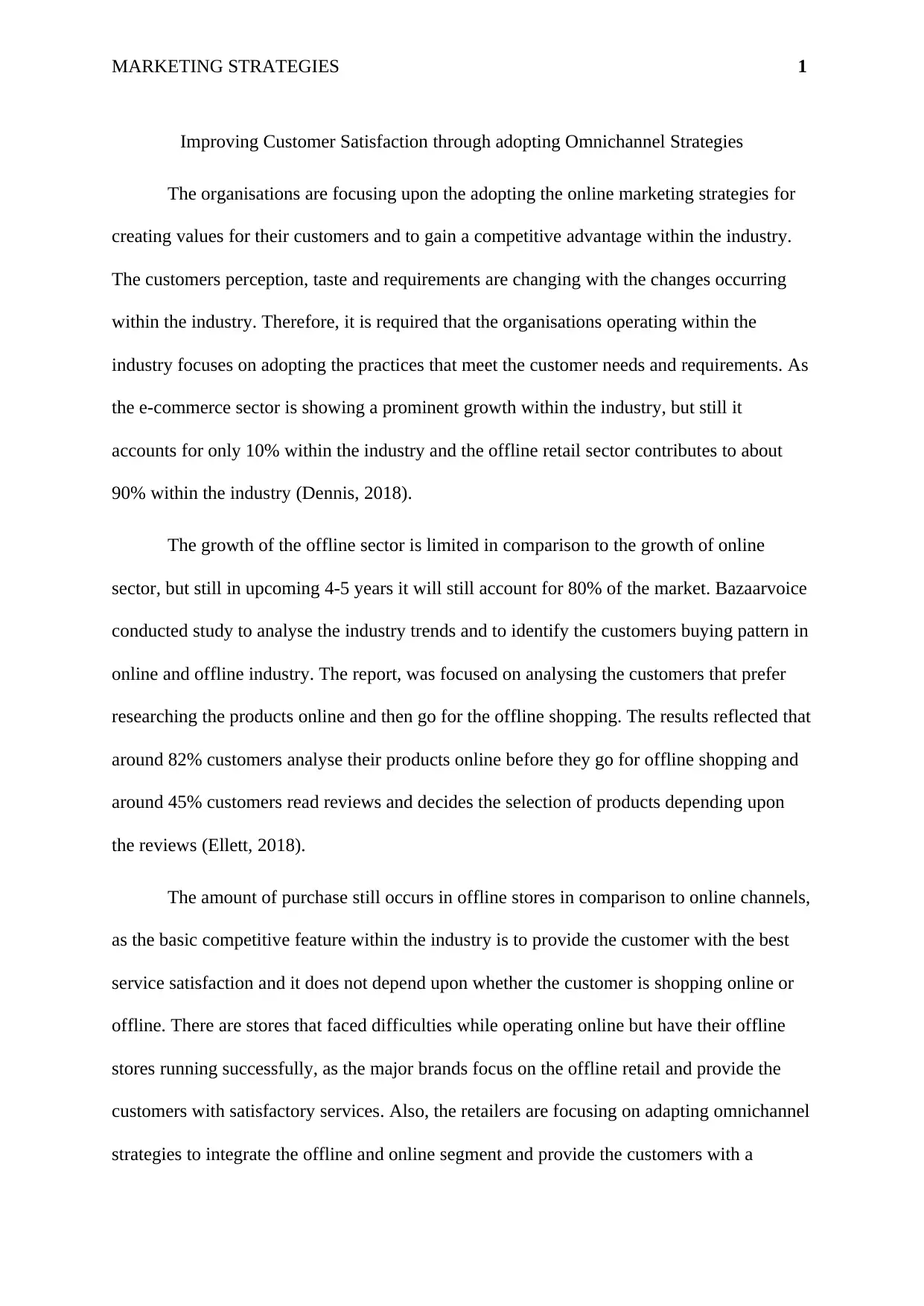
MARKETING STRATEGIES 1
Improving Customer Satisfaction through adopting Omnichannel Strategies
The organisations are focusing upon the adopting the online marketing strategies for
creating values for their customers and to gain a competitive advantage within the industry.
The customers perception, taste and requirements are changing with the changes occurring
within the industry. Therefore, it is required that the organisations operating within the
industry focuses on adopting the practices that meet the customer needs and requirements. As
the e-commerce sector is showing a prominent growth within the industry, but still it
accounts for only 10% within the industry and the offline retail sector contributes to about
90% within the industry (Dennis, 2018).
The growth of the offline sector is limited in comparison to the growth of online
sector, but still in upcoming 4-5 years it will still account for 80% of the market. Bazaarvoice
conducted study to analyse the industry trends and to identify the customers buying pattern in
online and offline industry. The report, was focused on analysing the customers that prefer
researching the products online and then go for the offline shopping. The results reflected that
around 82% customers analyse their products online before they go for offline shopping and
around 45% customers read reviews and decides the selection of products depending upon
the reviews (Ellett, 2018).
The amount of purchase still occurs in offline stores in comparison to online channels,
as the basic competitive feature within the industry is to provide the customer with the best
service satisfaction and it does not depend upon whether the customer is shopping online or
offline. There are stores that faced difficulties while operating online but have their offline
stores running successfully, as the major brands focus on the offline retail and provide the
customers with satisfactory services. Also, the retailers are focusing on adapting omnichannel
strategies to integrate the offline and online segment and provide the customers with a
Improving Customer Satisfaction through adopting Omnichannel Strategies
The organisations are focusing upon the adopting the online marketing strategies for
creating values for their customers and to gain a competitive advantage within the industry.
The customers perception, taste and requirements are changing with the changes occurring
within the industry. Therefore, it is required that the organisations operating within the
industry focuses on adopting the practices that meet the customer needs and requirements. As
the e-commerce sector is showing a prominent growth within the industry, but still it
accounts for only 10% within the industry and the offline retail sector contributes to about
90% within the industry (Dennis, 2018).
The growth of the offline sector is limited in comparison to the growth of online
sector, but still in upcoming 4-5 years it will still account for 80% of the market. Bazaarvoice
conducted study to analyse the industry trends and to identify the customers buying pattern in
online and offline industry. The report, was focused on analysing the customers that prefer
researching the products online and then go for the offline shopping. The results reflected that
around 82% customers analyse their products online before they go for offline shopping and
around 45% customers read reviews and decides the selection of products depending upon
the reviews (Ellett, 2018).
The amount of purchase still occurs in offline stores in comparison to online channels,
as the basic competitive feature within the industry is to provide the customer with the best
service satisfaction and it does not depend upon whether the customer is shopping online or
offline. There are stores that faced difficulties while operating online but have their offline
stores running successfully, as the major brands focus on the offline retail and provide the
customers with satisfactory services. Also, the retailers are focusing on adapting omnichannel
strategies to integrate the offline and online segment and provide the customers with a
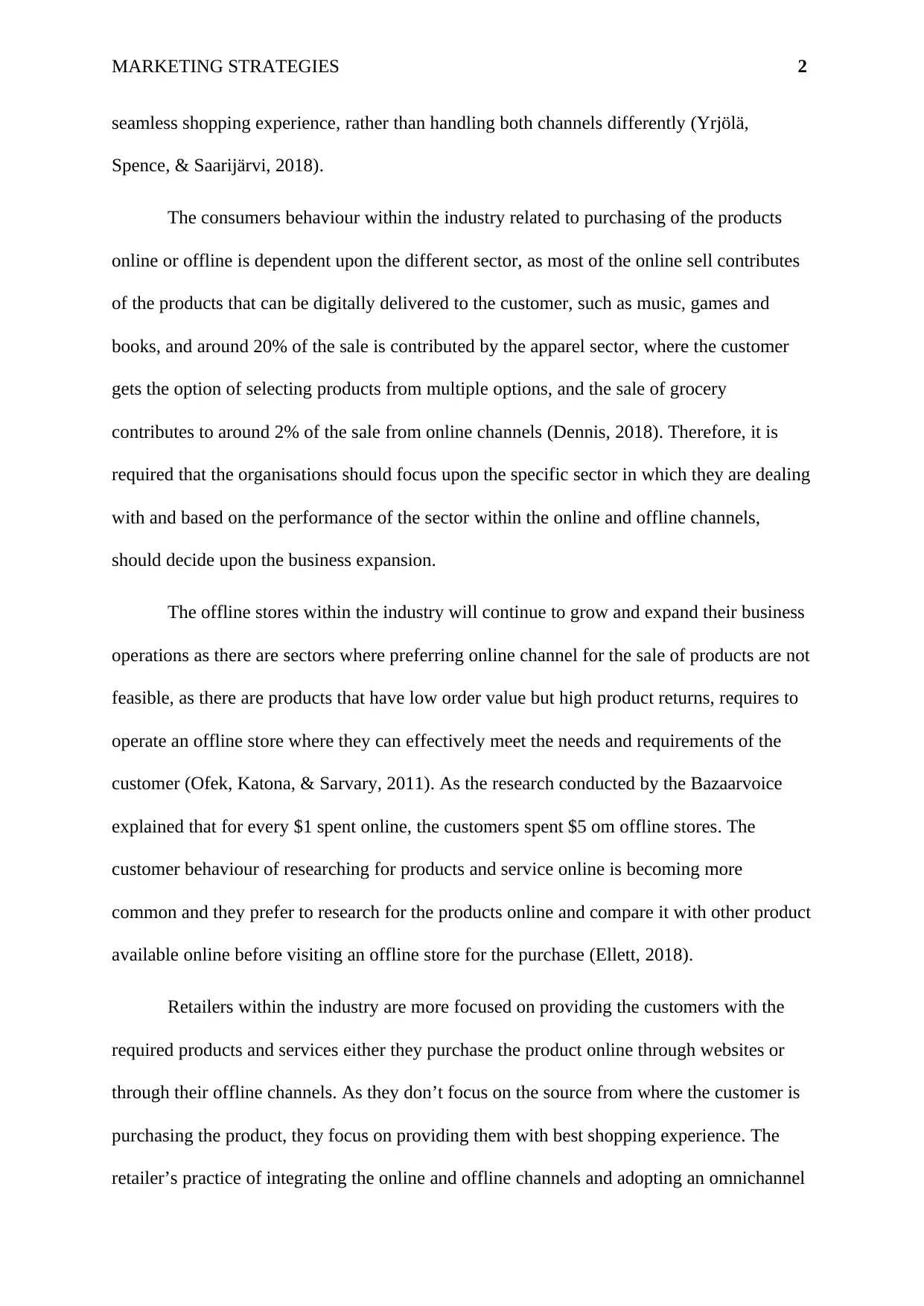
MARKETING STRATEGIES 2
seamless shopping experience, rather than handling both channels differently (Yrjölä,
Spence, & Saarijärvi, 2018).
The consumers behaviour within the industry related to purchasing of the products
online or offline is dependent upon the different sector, as most of the online sell contributes
of the products that can be digitally delivered to the customer, such as music, games and
books, and around 20% of the sale is contributed by the apparel sector, where the customer
gets the option of selecting products from multiple options, and the sale of grocery
contributes to around 2% of the sale from online channels (Dennis, 2018). Therefore, it is
required that the organisations should focus upon the specific sector in which they are dealing
with and based on the performance of the sector within the online and offline channels,
should decide upon the business expansion.
The offline stores within the industry will continue to grow and expand their business
operations as there are sectors where preferring online channel for the sale of products are not
feasible, as there are products that have low order value but high product returns, requires to
operate an offline store where they can effectively meet the needs and requirements of the
customer (Ofek, Katona, & Sarvary, 2011). As the research conducted by the Bazaarvoice
explained that for every $1 spent online, the customers spent $5 om offline stores. The
customer behaviour of researching for products and service online is becoming more
common and they prefer to research for the products online and compare it with other product
available online before visiting an offline store for the purchase (Ellett, 2018).
Retailers within the industry are more focused on providing the customers with the
required products and services either they purchase the product online through websites or
through their offline channels. As they don’t focus on the source from where the customer is
purchasing the product, they focus on providing them with best shopping experience. The
retailer’s practice of integrating the online and offline channels and adopting an omnichannel
seamless shopping experience, rather than handling both channels differently (Yrjölä,
Spence, & Saarijärvi, 2018).
The consumers behaviour within the industry related to purchasing of the products
online or offline is dependent upon the different sector, as most of the online sell contributes
of the products that can be digitally delivered to the customer, such as music, games and
books, and around 20% of the sale is contributed by the apparel sector, where the customer
gets the option of selecting products from multiple options, and the sale of grocery
contributes to around 2% of the sale from online channels (Dennis, 2018). Therefore, it is
required that the organisations should focus upon the specific sector in which they are dealing
with and based on the performance of the sector within the online and offline channels,
should decide upon the business expansion.
The offline stores within the industry will continue to grow and expand their business
operations as there are sectors where preferring online channel for the sale of products are not
feasible, as there are products that have low order value but high product returns, requires to
operate an offline store where they can effectively meet the needs and requirements of the
customer (Ofek, Katona, & Sarvary, 2011). As the research conducted by the Bazaarvoice
explained that for every $1 spent online, the customers spent $5 om offline stores. The
customer behaviour of researching for products and service online is becoming more
common and they prefer to research for the products online and compare it with other product
available online before visiting an offline store for the purchase (Ellett, 2018).
Retailers within the industry are more focused on providing the customers with the
required products and services either they purchase the product online through websites or
through their offline channels. As they don’t focus on the source from where the customer is
purchasing the product, they focus on providing them with best shopping experience. The
retailer’s practice of integrating the online and offline channels and adopting an omnichannel
⊘ This is a preview!⊘
Do you want full access?
Subscribe today to unlock all pages.

Trusted by 1+ million students worldwide
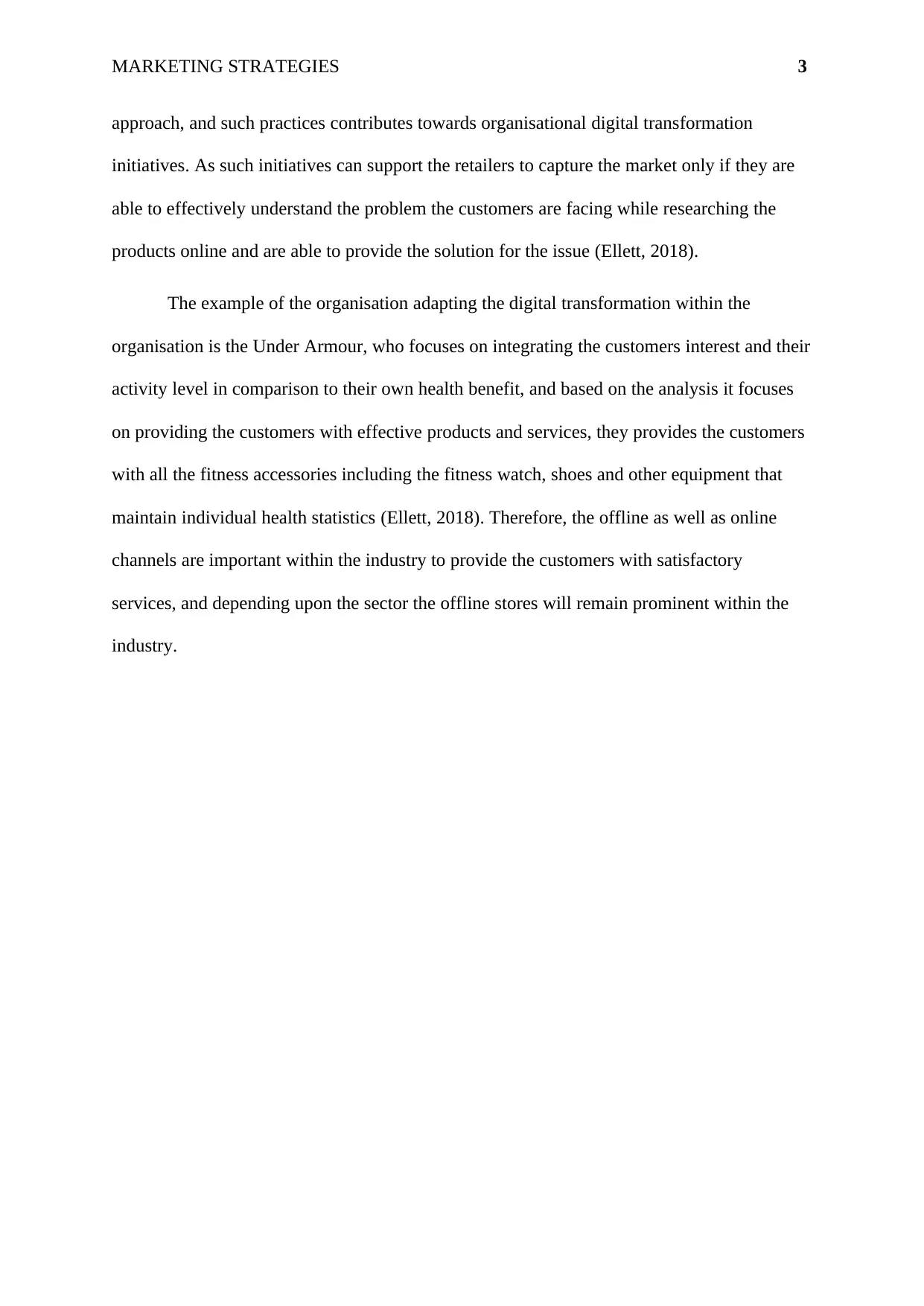
MARKETING STRATEGIES 3
approach, and such practices contributes towards organisational digital transformation
initiatives. As such initiatives can support the retailers to capture the market only if they are
able to effectively understand the problem the customers are facing while researching the
products online and are able to provide the solution for the issue (Ellett, 2018).
The example of the organisation adapting the digital transformation within the
organisation is the Under Armour, who focuses on integrating the customers interest and their
activity level in comparison to their own health benefit, and based on the analysis it focuses
on providing the customers with effective products and services, they provides the customers
with all the fitness accessories including the fitness watch, shoes and other equipment that
maintain individual health statistics (Ellett, 2018). Therefore, the offline as well as online
channels are important within the industry to provide the customers with satisfactory
services, and depending upon the sector the offline stores will remain prominent within the
industry.
approach, and such practices contributes towards organisational digital transformation
initiatives. As such initiatives can support the retailers to capture the market only if they are
able to effectively understand the problem the customers are facing while researching the
products online and are able to provide the solution for the issue (Ellett, 2018).
The example of the organisation adapting the digital transformation within the
organisation is the Under Armour, who focuses on integrating the customers interest and their
activity level in comparison to their own health benefit, and based on the analysis it focuses
on providing the customers with effective products and services, they provides the customers
with all the fitness accessories including the fitness watch, shoes and other equipment that
maintain individual health statistics (Ellett, 2018). Therefore, the offline as well as online
channels are important within the industry to provide the customers with satisfactory
services, and depending upon the sector the offline stores will remain prominent within the
industry.
Paraphrase This Document
Need a fresh take? Get an instant paraphrase of this document with our AI Paraphraser
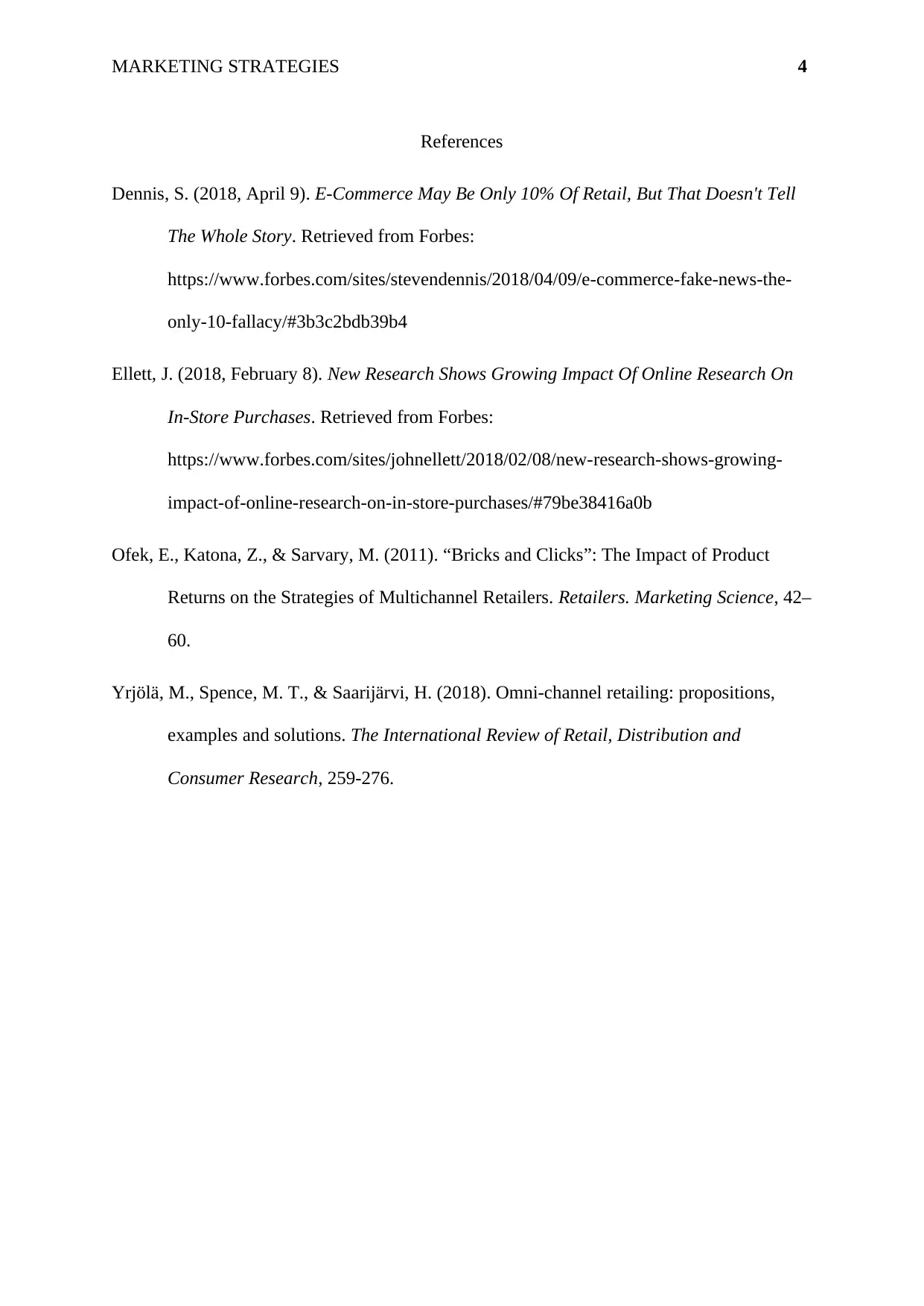
MARKETING STRATEGIES 4
References
Dennis, S. (2018, April 9). E-Commerce May Be Only 10% Of Retail, But That Doesn't Tell
The Whole Story. Retrieved from Forbes:
https://www.forbes.com/sites/stevendennis/2018/04/09/e-commerce-fake-news-the-
only-10-fallacy/#3b3c2bdb39b4
Ellett, J. (2018, February 8). New Research Shows Growing Impact Of Online Research On
In-Store Purchases. Retrieved from Forbes:
https://www.forbes.com/sites/johnellett/2018/02/08/new-research-shows-growing-
impact-of-online-research-on-in-store-purchases/#79be38416a0b
Ofek, E., Katona, Z., & Sarvary, M. (2011). “Bricks and Clicks”: The Impact of Product
Returns on the Strategies of Multichannel Retailers. Retailers. Marketing Science, 42–
60.
Yrjölä, M., Spence, M. T., & Saarijärvi, H. (2018). Omni-channel retailing: propositions,
examples and solutions. The International Review of Retail, Distribution and
Consumer Research, 259-276.
References
Dennis, S. (2018, April 9). E-Commerce May Be Only 10% Of Retail, But That Doesn't Tell
The Whole Story. Retrieved from Forbes:
https://www.forbes.com/sites/stevendennis/2018/04/09/e-commerce-fake-news-the-
only-10-fallacy/#3b3c2bdb39b4
Ellett, J. (2018, February 8). New Research Shows Growing Impact Of Online Research On
In-Store Purchases. Retrieved from Forbes:
https://www.forbes.com/sites/johnellett/2018/02/08/new-research-shows-growing-
impact-of-online-research-on-in-store-purchases/#79be38416a0b
Ofek, E., Katona, Z., & Sarvary, M. (2011). “Bricks and Clicks”: The Impact of Product
Returns on the Strategies of Multichannel Retailers. Retailers. Marketing Science, 42–
60.
Yrjölä, M., Spence, M. T., & Saarijärvi, H. (2018). Omni-channel retailing: propositions,
examples and solutions. The International Review of Retail, Distribution and
Consumer Research, 259-276.
1 out of 5
Related Documents
Your All-in-One AI-Powered Toolkit for Academic Success.
+13062052269
info@desklib.com
Available 24*7 on WhatsApp / Email
![[object Object]](/_next/static/media/star-bottom.7253800d.svg)
Unlock your academic potential
Copyright © 2020–2025 A2Z Services. All Rights Reserved. Developed and managed by ZUCOL.





